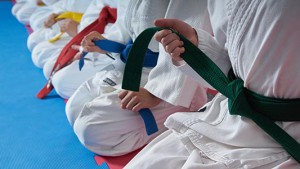 For centuries, martial arts practitioners have looked to the various disciplines of Karate, Judo, Taekwondo, Jiu-Jitsu, and countless other forms of self-defense, as a way to build confidence, strength, and discipline.
For centuries, martial arts practitioners have looked to the various disciplines of Karate, Judo, Taekwondo, Jiu-Jitsu, and countless other forms of self-defense, as a way to build confidence, strength, and discipline.
Many people unfamiliar with martial arts see the sport as an aggressive endeavor that focuses solely on the physical domination of an opponent. But those who practice martial arts know that fighting is the last resort in the event of a confrontation. In addition to self-defense, karate teaches students about the importance of respect, humility, hard work, and perseverance.
The hierarchy of the dojo, a gym where martial arts are practiced, is much like a work environment. The leader of the dojo is called “sensei.” The word sensei is a term of honor that literally translates to “teacher.” The sensei is in charge of leading students, helping them acquire the skills they need to advance while also instilling and strengthening the values of the dojo.
Master Gichin Funakoshi (1868 – 1957), recognized as the father of modern karate said, “Success cannot be attained alone. Any person’s time and power is limited. A wise leader enlists others in working toward organizational goals.”
There is no first attack
Despite what you see in the movies and on TV, karate teaches students not to fight, a value ingrained from the first day in the dojo. What is taught is that self-control is crucial, especially in the face of aggression. It’s easy to lash out and let your emotions get the better of you, but a true leader remains calm when challenged with antagonistic behavior.
When a person voices displeasure, the calm leader acknowledges the person’s feelings and seeks to diffuse the situation. Often this is enough to de-escalate a volatile situation. If tensions continue to rise, a direct statement such as, “I don’t want to fight with you. Let’s talk this through. I want to find a solution,” will make it clear to the aggressor that there is a better way to solve the problem.
If you fall down seven times, get up eight
The path to success is rarely an easy one. Nearly everyone faces struggles, challenges, and obstacles along the way. How you react to these challenges is how you are defined by others. The successful leader accepts that failure is a reality of life. Take the opportunity to learn from both success and failure. Analyze the situation to determine where you went wrong and what could be done in the future to create a positive outcome.
Compare a time when you failed versus an instance where you experienced success. What was the difference? What could you have done better to ensure a more positive outcome? The key is to always put forth your best effort and never stop trying. There is a saying in the dojo, “You don’t fail until you give up.”
Give others the opportunity to lead
In the dojo, the sensei is the boss. But as with any good manager, he or she allows others to help lead the less experienced karateka (karate students). This helps those in the dojo with advanced belts gain valuable leadership experience and learn the intricacies of leading a group of people with different personalities and varying levels of experience.
A wise sensei also provides leadership opportunities to students with lower ranking belts. The benefits are numerous. Less experienced students gain a glimpse into the responsibilities of leadership, while also serving as a confidence builder and motivation to pursue advanced belts. It’s also a great opportunity for the sensei to evaluate the student and determine an appropriate development path.
We are here to help, not hurt each other
Every dojo embodies the spirit of family and community. The fact that the members are part of something unique and special creates a bond between them. Students are taught the history of karate, its origins, and founders.
New students are assigned an experienced person who helps introduce the various techniques, teaches them how to tie the unique knot in their karate belt, and when to bow to senior members of the dojo. As they line up to begin class, students with more advanced belts form the rows at the front of the class, with the more recent members lined up behind them. This serves two purposes. Beginners can see and learn from the advanced students in front of them. At the same time, the advanced students realize that they are being observed by the inexperienced and are responsible for setting a good example. When it’s time to spar, great emphasis is placed on restraint. Students are taught to focus on perfecting their technique, not inflicting harm upon their opponent.
The path to earning the title of sensei is long and difficult. But the achievement is recognized as a symbol of skill and perseverance, even to people unfamiliar with the martial arts. Gaining your leadership black belt involves embracing many of the same ideologies of the martial arts: loyalty, humility, courage, and honor. Incorporate these traits in to your leadership style and you’ll be well on your way to leadership success.

What great lessons!
Great one! Sharing it.
BTW on the same “line of thoughts”, I wrote an article on social media and martial arts.
It’s more on the humoristic side. Happy reading The Digital Dojo of Social Media Mastery. Link is here : https://www.linkedin.com/pulse/digital-dojo-social-media-mastery-vincent-brissot-1/
Happy reading